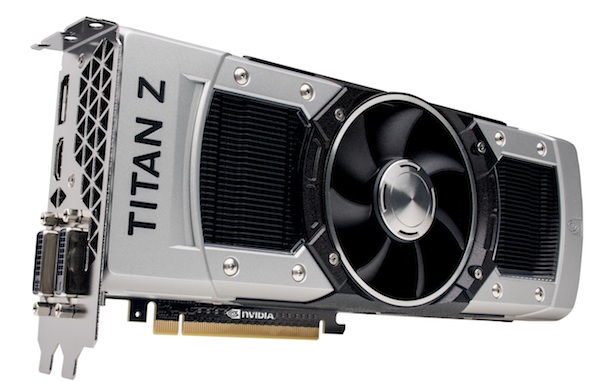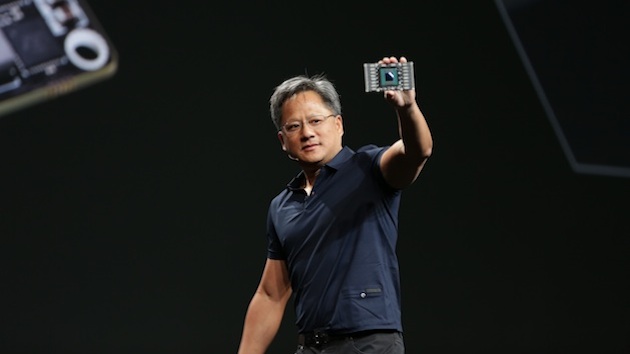Advances in GPU Technology Mean More Power Now and Fast, Smaller and More Efficient GPUs Coming Soon
At Nvidia's GPU Technology Conference in San Jose today, CEO Jen-Hsun Huang laid out his company's development roadmap for the "coming era of unified simulation and computer graphics," unveiling a suite of new technology and products that the company says will power next-generation visual effects but also bring supercomputing graphics processing to robotic devices, automotive digital prototyping and self-driving cars. Using a series of demos and visualizations that spanned artificial intelligence and a re-imagining of Rhythm & Hues' Academy Award-winning visual effects for Life of Pi, Huang put Nvidia's next-generation GPU technology within the context of varied applications.
Huang introduced the coming version of the company's GPU architecture, Pascal (shown by Huang, above, during his keynote presentation), as well as a $192 toolkit called the Jetson TK1 SDK that opens up the supercomputing Tegra K1 mobile chip—a building block in the coming iteration of self-driving and driver-assisted cars—to developers of space-constrained robotic devices. Developed to leapfrog current bandwidth bottlenecks that result from the speed-limiting exchanges between CPUs and GPUs crunching ever-increasing amounts of data, Pascal features a PCIe alternative called NVLink, essentially a dedicated GPU socket that increases throughput by five to 12 times over what's possible in Kepler GPUs. A new kind of GPU packaging, or stacked DRAM, that sandwiches a 3D memory chip onto the GPU chip wafer is Nvidia's solution to adding processing speed and power without bulking up the GPU's physical size, already "the biggest chip in the world," said Huang. As a result, Pascal will be about one-third the size of a typical PCIe bus as well as four times as energy efficient as current GPU chips.

Huang also bowed Nvidia Grid technology that will bring virtualized desktops and apps to the public cloud with partner VMware and GeForce GTX Titan Z, a dual-GPU version of its Titan graphics card built on its Kepler compute architecture and featuring 12 GB frame buffer memory and some 5,760 processing cores. Although the Titan Z is aimed at "5K and multi-monitor gaming," Huang specifically mentioned the legions of editors and other creatives who could benefit from the Titan's processing power. (Nvidia, however, recommends its partner-tested Quadro cards optimized for video editing and compositing as a first choice.) The Titan Z lists for $3,000 and is scheduled to begin shipping in April.
The company's new visual computing rendering appliance, Iray VCA, is already being used by Honda Research and Development to create complex photoreal, interactive digital prototypes it hopes will eventually replace more costly and time-consuming physical prototyping and shave months off of design and review time in general. An extension of Nvidia's Iray renderer already inside software like 3ds Max and Maya, Iray VCA uses hardware and software—12 GB of graphics memory and 8 GPUs—to accelerate ray-tracing for highly detailed and photoreal 3D models. Iray is aimed at 3D product rendering and does a great job of rendering real environments. It does not however do hair or fur, or any number of imagined looks, which is why Nvidia's Mental Ray is still better suited to film and visual effects. An engineer from Honda demonstrated a car design that could be turned and manipulated in real time and stripped of its exterior layers to reveal the complex machinery and engine beneath. But imagine being able to do the same thing with real-time global illumination when creating a shorter project, like a car commercial or a spot for some other bright and shiny product. The appliance lists for $50,000 and will be available this summer.
The kicker was Audi's self-piloted prototype—an actual car, not a digital one—that drove itself on stage to close Huang's keynote. The car contained its own trunk-sized supercomputer that will no doubt shrink as these GPU improvements play out and automakers like Audi and others begin mass producing these cars of the future.
Nvidia's annual GPU Technology Conference, which features four days of talks, specialized sessions and partner and developer exhibitions, was held for the first time in 2009. It continues through Thursday.












Leave a Reply